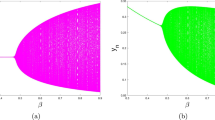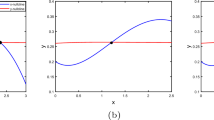Abstract
We consider a mathematical model of nutrient-autotroph-herbivore interaction with nutrient recycling from both autotroph and herbivore. Local and global stability criteria of the model are studied in terms of system parameters. Next we incorporate the time required for recycling of nutrient from herbivore as a constant discrete time delay. The resulting DDE model is analyzed regarding stability and bifurcation aspects. Finally, we assume the recycling delay in the oscillatory form to model the daily variation in nutrient recycling and deduce the stability criteria of the variable delay model. A comparison of the variable delay model with the constant delay one is performed to unearth the biological relevance of oscillating delay in some real world ecological situations. Numerical simulations are done in support of analytical results.
Similar content being viewed by others
References
M. Bandyopadhyay, R. Bhattacharyya, B. Mukhopadhyay: Dynamics of an autotrophherbivore ecosystem with nutrient recycling. Ecol. Model. 176 (2004), 201–209.
E. Beltrami, T.O. Carroll: Modeling the role of viral disease in recurrent phytoplankton blooms. J. Math. Biol. 32 (1994), 857–863.
D. L. Benson, J.A. Sherratt, P.K. Maini: Diffusion driven instability in an inhomogeneous domain. Bull. Math. Biol. 55 (1993), 365–384.
D. L. Benson, P.K. Maini, J.A. Sherratt: Pattern formation in reaction-diffusion models with spatially inhomogeneous diffusion coefficients. Math. Comp. Model. 17 (1993), 29–34.
E. Beretta, G. I. Bischi, F. Solimano: Stability in chemostat equations with delayed recycling. J. Math. Biol. 28 (1990), 99–111.
R. Bhattacharyya, B. Mukhopadhyay: Oscillation and persistence in a mangrove ecosystem in presence of delays. J. Biol. Syst. 11 (2003), 351–364.
G. I. Bischi: Effects of time lags on transient characteristics of a nutrient recycling model. Math. Biosci. 109 (1992), 151–175.
P. Colinvaux: Ecology II. John Wiley & Sons, Chichester, 1993.
M. J. Crawley: Herbivory. The dynamics of animal plant interaction. Studies in Ecology Vol. 10. University of California Press, Berkley, 1983.
D. I. De Angelis, S.M. Bartell, A. L. Brenkert: Effect of nutrient recycling and food chain length on the resilience. Amer. Naturalist 134 (1989), 778–805.
D. L. De Angelis: Dynamics of Nutrient Recycling and Food Webs. Chapman & Hall, London, 1992.
M. Farkas, H. I. Freedman: The stable coexistence of competing species on a renewable resource. J. Math. Anal. Appl. 138 (1989), 461–472.
D. Ghosh, A.K. Sarkar: Oscillatory behaviour of an autotroph-herbivore system with a type-III uptake function. Int. J. Syst. Sci. 28 (1997), 259–264.
D. Ghosh, A.K. Sarkar: Stability and oscillations in a resource-based model of two interacting species with nutrient cycling. Ecol. Model. 107 (1998), 25–33.
D. Ghosh, A.K. Sarkar: Qualitative analysis of autotroph-herbivore system with nutrient diffusion. Korean J. Comput. Appl. Math. 6 (1999), 589–599.
T.G. Hallam: Structural sensitivity of grazing formulations in nutrient controlled plankton models. J. Math. Biol. 5 (1978), 261–280.
B.D. Hassard, N.D. Kazarinoff, Y.-H. Wan: Theory and Applications of Hopf Bifurcation. Cambridge University Press, Cambridge, 1981.
C. S. Holling: The functional response population regulation. Mem. Entomol. Soc. Can. 45 (1965), 1–60.
S.R.-J. Jang: Dynamics of variable-yield nutrient-phytoplankton-zooplankton models with nutrient recycling and self-shading. J. Math. Biol. 40 (2000), 229–250.
E. Kreysig: Introductory Functional Analysis with Applications. John Wiley & Sons, New York, 1978.
D. Ludwig, D.D. Jones, C. S. Holling: Qualitative analysis of insect outbreak systems: the spruce budworm and forest. J. Anim. Econ. 47 (1978), 315–332.
P.K. Maini, D. L. Benson, J.A. Sherratt: Pattern formation in reaction-diffusion models with spatially inhomogeneous diffusion coefficients. IMA J. Math. Appl. Med. Biol. 9 (1992), 197–213.
D. Mukherjee, S. Ray, D.K. Sinha: Bifurcation analysis of a detritus-based ecosystem with time delay. J. Biol. Syst. 8 (2000), 255–261.
B. Mukopadhyay, R. Bhattacharyya: A delay-diffusion model of marine plankton ecosystem exhibiting cyclic nature of blooms. J. Biol. Phys. 31 (2005), 3–22.
B. Mukopadhyay, R. Bhattacharyya: Modelling phytoplankton allelopathy in a nutrient-plankton model with spatial heterogeneity. Ecol. Model. 198 (2006), 163–173.
B. Mukhopadhyay, R. Bhattacharyya: Modeling the role of diffusion coefficients on Turing instability in a reaction-diffusion prey-predator system. Bull. Math. Biol. 68 (2006), 293–313.
S. Muratori, S. Rinaldi: Low- and high-frequency oscillations in three-dimensional food chain systems. SIAM J. Appl. Math. 52 (1992), 1688–1706.
R.M. Nisbet, J. Mckinstry, W. S.C. Gurney: A “strategic” model of material cycling in a closed ecosystem. Math. Biosci. 64 (1983), 99–113.
O. Pardo: Global stability for a phytoplankton-nutrient system. J. Biol. Syst. 8 (2000), 195–209.
T. Powell, P. J. Richardson: Temporal variation, spatial heterogeneity and competition for resources in plankton systems: theoretical models. Am. Nat. 125 (1985), 431–463.
S. Ruan: Persistence and coexistence in zooplankton-phytoplankton-nutrient models with instantaneous nutrient recycling. J. Math. Biol. 31 (1993), 633–654.
S. Ruan: The effect of delays on stability and persistence in plankton models. Nonlinear Anal., Theory Methods Appl. 24 (1995), 575–585.
S. Ruan: Oscillations in plankton models with nutrient recycling. J. Theor. Biol. 208 (2001), 15–26.
S. Ruan, G. Wolkowicz: Uniform persistence in plankton models with delayed nutrient recycling. Can. Appl. Math. Q. 3 (1995), 219–235.
A.K. Sarkar, D. Mitra, S. Roy, A.B. Roy: Permanence and oscillatory co-existence of a detritus-based prey-predator model. Ecol. Model. 53 (1991), 147–156.
A.K. Sarkar, A.B. Roy: Oscillatory behavior in a resource-based plant-herbivore model with random herbivore attack. Ecol. Model. 68 (1993), 213–226.
A. Sikder, A.B. Roy: Limit cycles in a prey-predator systems. Appl. Math. Lett. 6 (1993), 91–95.
D. Schley, S.A. Gourley: Linear stability criteria for population models with periodically perturbed delays. J. Math. Biol. 40 (2000), 500–524.
J.A. Sherratt: Turing bifurcations with a temporally varying diffusion coefficient. J. Math. Biol. 33 (1995), 295–308.
J.A. Sherratt: Diffusion-driven instability in oscillating environments. Eur. J. Appl. Math. 6 (1995), 355–372.
O. L. Smith: Food Webs. Chapman & Hall, London, 1982.
Y.M. Svirezhev, D.O. Logofet: Stability of Biological Communities. Mir, Moscow, 1983.
R.H. Whittaker: Communities and Ecosystems. Macmillan, New York, 1975.
Author information
Authors and Affiliations
Corresponding author
Additional information
The present research is performed under a project supported by the Department of Science and Technology, Ministry of Human Resource Development, Govt. of India (Grant No. SR/S4/MS:296/05).
Rights and permissions
About this article
Cite this article
Mukhopadhyay, B., Bhattacharyya, R. Modeling the role of constant and time varying recycling delay on an ecological food chain. Appl Math 55, 221–240 (2010). https://doi.org/10.1007/s10492-010-0009-5
Received:
Published:
Issue Date:
DOI: https://doi.org/10.1007/s10492-010-0009-5
Keywords
- autotroph
- herbivore
- nutrient recycling
- global stability
- Hopf-bifurcation
- variable delay
- two-timing expansion




